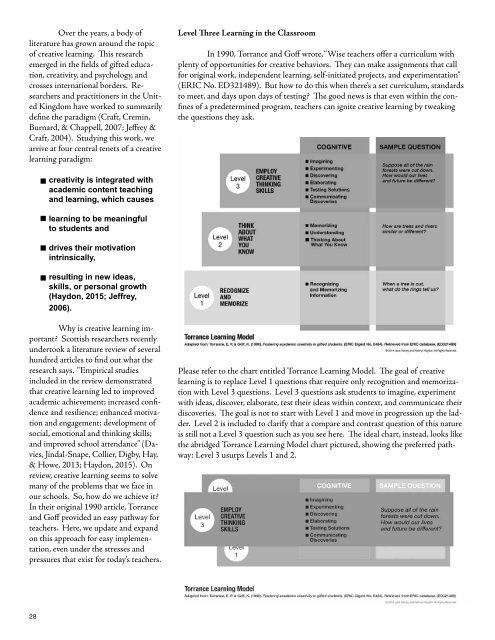Torrance Journal for Applied Creativity
TorranceJournal_V1
TorranceJournal_V1
You also want an ePaper? Increase the reach of your titles
YUMPU automatically turns print PDFs into web optimized ePapers that Google loves.
Over the years, a body of<br />
literature has grown around the topic<br />
of creative learning. This research<br />
emerged in the fields of gifted education,<br />
creativity, and psychology, and<br />
crosses international borders. Researchers<br />
and practitioners in the United<br />
Kingdom have worked to summarily<br />
define the paradigm (Craft, Cremin,<br />
Burnard, & Chappell, 2007; Jeffrey &<br />
Craft, 2004). Studying this work, we<br />
arrive at four central tenets of a creative<br />
learning paradigm:<br />
Level Three Learning in the Classroom<br />
In 1990, <strong>Torrance</strong> and Goff wrote, “Wise teachers offer a curriculum with<br />
plenty of opportunities <strong>for</strong> creative behaviors. They can make assignments that call<br />
<strong>for</strong> original work, independent learning, self-initiated projects, and experimentation”<br />
(ERIC No. ED321489). But how to do this when there’s a set curriculum, standards<br />
to meet, and days upon days of testing? The good news is that even within the confines<br />
of a predetermined program, teachers can ignite creative learning by tweaking<br />
the questions they ask.<br />
creativity is integrated with<br />
academic content teaching<br />
and learning, which causes<br />
learning to be meaningful<br />
to students and<br />
drives their motivation<br />
intrinsically,<br />
resulting in new ideas,<br />
skills, or personal growth<br />
(Haydon, 2015; Jeffrey,<br />
2006).<br />
Why is creative learning important?<br />
Scottish researchers recently<br />
undertook a literature review of several<br />
hundred articles to find out what the<br />
research says. “Empirical studies<br />
included in the review demonstrated<br />
that creative learning led to improved<br />
academic achievement; increased confidence<br />
and resilience; enhanced motivation<br />
and engagement; development of<br />
social, emotional and thinking skills;<br />
and improved school attendance” (Davies,<br />
Jindal-Snape, Collier, Digby, Hay,<br />
& Howe, 2013; Haydon, 2015). On<br />
review, creative learning seems to solve<br />
many of the problems that we face in<br />
our schools. So, how do we achieve it?<br />
In their original 1990 article, <strong>Torrance</strong><br />
and Goff provided an easy pathway <strong>for</strong><br />
teachers. Here, we update and expand<br />
on this approach <strong>for</strong> easy implementation,<br />
even under the stresses and<br />
pressures that exist <strong>for</strong> today’s teachers.<br />
Please refer to the chart entitled <strong>Torrance</strong> Learning Model. The goal of creative<br />
learning is to replace Level 1 questions that require only recognition and memorization<br />
with Level 3 questions. Level 3 questions ask students to imagine, experiment<br />
with ideas, discover, elaborate, test their ideas within context, and communicate their<br />
discoveries. The goal is not to start with Level 1 and move in progression up the ladder.<br />
Level 2 is included to clarify that a compare and contrast question of this nature<br />
is still not a Level 3 question such as you see here. The ideal chart, instead, looks like<br />
the abridged <strong>Torrance</strong> Learning Model chart pictured, showing the preferred pathway:<br />
Level 3 usurps Levels 1 and 2.<br />
28


